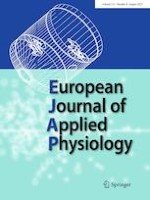Published in:

01-08-2021 | Cryotherapy | Invited Review
The cold truth: the role of cryotherapy in the treatment of injury and recovery from exercise
Authors:
Susan Y. Kwiecien, Malachy P. McHugh
Published in:
European Journal of Applied Physiology
|
Issue 8/2021
Login to get access
Abstract
Cryotherapy is utilized as a physical intervention in the treatment of injury and exercise recovery. Traditionally, ice is used in the treatment of musculoskeletal injury while cold water immersion or whole-body cryotherapy is used for recovery from exercise. In humans, the primary benefit of traditional cryotherapy is reduced pain following injury or soreness following exercise. Cryotherapy-induced reductions in metabolism, inflammation, and tissue damage have been demonstrated in animal models of muscle injury; however, comparable evidence in humans is lacking. This absence is likely due to the inadequate duration of application of traditional cryotherapy modalities. Traditional cryotherapy application must be repeated to overcome this limitation. Recently, the novel application of cooling with 15 °C phase change material (PCM), has been administered for 3–6 h with success following exercise. Although evidence suggests that chronic use of cryotherapy during resistance training blunts the anabolic training effect, recovery using PCM does not compromise acute adaptation. Therefore, following exercise, cryotherapy is indicated when rapid recovery is required between exercise bouts, as opposed to after routine training. Ultimately, the effectiveness of cryotherapy as a recovery modality is dependent upon its ability to maintain a reduction in muscle temperature and on the timing of treatment with respect to when the injury occurred, or the exercise ceased. Therefore, to limit the proliferation of secondary tissue damage that occurs in the hours after an injury or a strenuous exercise bout, it is imperative that cryotherapy be applied in abundance within the first few hours of structural damage.
